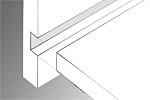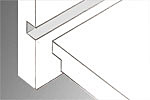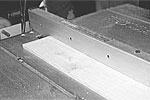
|
EZ Dado & Groove Joints - How to Make Dados the Easy Way |
It doesn’t take long to exhaust all the possibilities for projects using simple butt joints and lap joints. When you reach that point in your woodworking, you’ll be ready to move on to dados, grooves, and rabbets. What makes this type of joinery so popular is its strength and durability - which makes it perfect for supporting shelves in bookcase plans. That strength comes from the way the boards interlock with each other through a series of grooves and notches.
|
 |
 |
 |
 |
|||||
Basic Dado JointDados are fairly easy to cut, as long as you have the right tools and the proper tool set up. The easiest way to cut dados is with hand-held router, a straight bit, and a simple alignment jig. |
Blind Dado JointThe trick to making a blind dado is cutting out an accurately sized notch. Some woodworkers prefer to do this my hand, using a small dovetail joint saw and a sharp chisel to carefully make the cut. |
Rabbet & Dado JointJust about any variation of the rabbet & dado joint can be pulled off with either a table saw and dado blade and/or a router using a dado jig. Use your wood stock to find the correct groove width. |
Table Saw DadoesMost of the tearout trouble caused by dado blades happens along the edge of the board - where the wood fibers are most fragile. One simple solution to avoid this problem is to first cut the dadoes on an oversized board |
|
First let’s clarify some terminology. A groove is just what the name implies…a hollowed out path that you cut along the length of a board. A dado is also a groove, but dados run across the grain, usually at the end of a board. A common place you’ll find dados and is in a bookcase, where the ends of the shelves are neatly tucked into a series of dados cut in the sides of the case. A common place you'll find grooves is along the edges of a box, where the top, sides, and back slide neatly into the grooves to hold everything together. There are a number of ways to get fairly clean grooves and dados using different tools. In fact, long before electricity made its way into the shop, woodworkers cut all their grooves and dadoes with hand saws and wood chisels. Today you’ll find plenty of woodworkers still using some variation of that technique to cut grooves and dados, but their methods will usually include a power tool at some point in the process. For example, some builders like to use a circular saw to cut each side of a groove and then dig out the center with a hand chisel. This method may be a little crude (and dangerous), but for many it’s a quick way to get the job done. That said, there’s no arguing that some tools are simply better designed for cutting grooves and dados, namely, routers and table saws. They take a little longer to set up, but will probably give you better (and safer) results. If you don’t have table saw, the router method is definitely the cheaper way to go. And in most cases, a router will give you the best results. |
|
|
|
